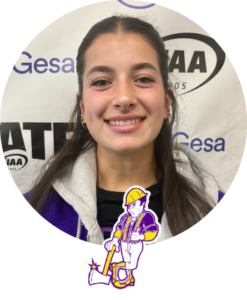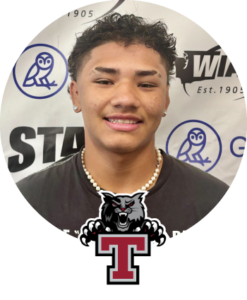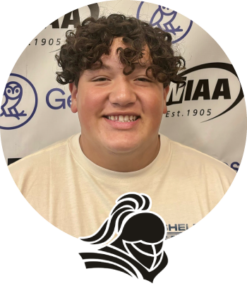atrebilcock
What Now? Separating My Identity from Athletics – By Kara Ma, The Bush School (’25)
WHAT NOW? SEPARATING MYSELF FROM ATHLETICS – BY KARA MA, THE BUSH SCHOOL (’25)
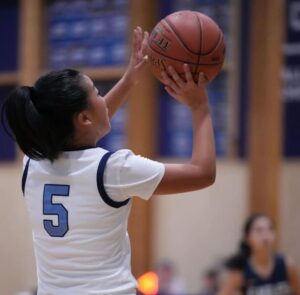 When I first started playing sports, I never thought about the last time I would play a basketball game, race a 5K, or compete in a track meet. As someone who has identified as an athlete for as long as I can remember, grappling with the idea of my last high school sports games has been incredibly difficult. To be honest, I think I’m still in denial about never playing an organized basketball game again. Earlier this year, I made the difficult decision to prioritize academics over athletics in college, and the emotional weight of that decision still sits heavily on me. It’s forced me to ask questions I hadn’t considered before: Who am I without being an athlete? How do I separate my identity from the only label that’s ever really stuck? Without realizing it, sports had become the framework of how I view myself. So maybe the better question isn’t “Who am I without sports?” Maybe it’s simply “Who am I, really?”
When I first started playing sports, I never thought about the last time I would play a basketball game, race a 5K, or compete in a track meet. As someone who has identified as an athlete for as long as I can remember, grappling with the idea of my last high school sports games has been incredibly difficult. To be honest, I think I’m still in denial about never playing an organized basketball game again. Earlier this year, I made the difficult decision to prioritize academics over athletics in college, and the emotional weight of that decision still sits heavily on me. It’s forced me to ask questions I hadn’t considered before: Who am I without being an athlete? How do I separate my identity from the only label that’s ever really stuck? Without realizing it, sports had become the framework of how I view myself. So maybe the better question isn’t “Who am I without sports?” Maybe it’s simply “Who am I, really?”
As a senior in high school, I am currently in an era of many endings and new beginnings, which is equally exciting and terrifying. Now that I am just a few weeks away from the end of my time in high school athletics, I’m stepping into unfamiliar territory that is filled with uncertainty. As a result, I am trying to figure out more about who I am. I have started to notice the parts of me that have existed all along, but have been overshadowed by sports.
Looking back, I realize sports taught me more about myself than I ever gave them credit for. Yes, they built my physical strength and endurance, but more importantly, they shaped my character. I know how to work toward long-term goals and be content without instant results or gratification. I learned how to show up for others even when I was tired, frustrated, or doubting myself. I know how to fail publicly and still leave the building with my head held high. I know how to lead, listen, and stay disciplined. The resilience that got me through tough games and injuries also helps me push through personal and academic challenges. These aren’t just athletic skills; they are life skills, and I am eternally grateful that sports gave them to me. Additionally, they won’t vanish just because my time as a high school athlete is ending.
Being an athlete has shaped me, but it surely doesn’t define me. As I start a new chapter of my life, I have to remember that who I am is not defined by awards and accolades. Who I am has never been defined by how many points I scored or how fast I ran; it’s been about my values, my actions, and the way I interact with those around me. While sports taught me how to push my limits and strive for excellence, it’s the relationships I’ve built and the impact I’ve had on others that truly shape my identity. Those are the things that will endure long after I complete my final seasons as a high school athlete.
There’s still a part of me that misses putting on my basketball uniform, practicing with my teammates, and going to AAU tournaments. After playing basketball for over ten years, part of me now feels empty. But I know that sports will always have a presence in my life. I will always watch basketball, play pickup games, and go for a run to boost my mood. However, now I have something new: space. Space to reflect. Space to grow. Space to figure out who I am without competing, being watched, or feeling judged. I’m discovering new things about myself that I didn’t fully know before. I’m learning that I can enjoy something just because it brings me joy, not just for the purpose of making me a better, faster, or stronger athlete. I’m learning how to be comfortable with uncertainty and how to chase goals that don’t come with a cheering crowd. Ultimately, I’m learning that stepping away from something doesn’t mean losing it. I may no
longer be an athlete in the traditional sense, but I still carry the heart of one; I will always be an athlete, it just looks different now. And slowly but surely, that’s starting to feel like enough.
Whether you are experiencing a transition period in your life, the end of your athletic career, or maybe you are starting something new, I hope you know you are not defined by what activities you do or your performance. You’re not leaving your identity behind. You’re simply bringing it with you into a new part of your life, where it can grow even stronger. You are your own person, and that will always be enough.
More than an Athlete: What I Learned about Identity, Faith, and Failing Forward – By Justyce Zuniga, Toppenish HS (’26)
MORE THAN AN ATHLETE: WHAT I LEARNED ABOUT IDENTITY, FAITH, AND FAILING FORWARD- BY JUSTYCE ZUNIGA, TOPPENISH HS (’26)
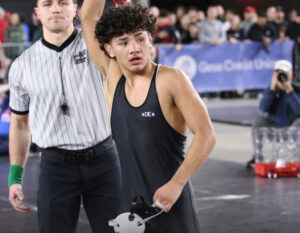
As a young athlete, so much of your identity gets wrapped up in your sport. Your wins define you. Your losses haunt you. And your mistakes? Let’s be honest, some adults will try to crucify you for them. Being an athlete is part of your story, but it’s not the whole thing.
As teenagers, we encounter numerous challenges that can swiftly transform our lives. Whether it’s something small like cutting in the lunch line or a critical six minutes of a wrestling match, one moment, everything feels normal, and the next, your whole perspective shifts. It can change how you view your school, your principals, and even the once-trusted adults around you. Sometimes, all it takes is one action, one choice, for a heavyweight to settle in. And that weight can make you feel judged, misunderstood, and even ashamed. The hardest part is realizing I’m not perfect; I will never be. But I also know this: I serve a God who gives me grace every single day. He doesn’t excuse my mistakes, but He offers me the chance to grow from them again and again.
If I could sit down with my freshman self, there’s a lot I’d say, but I’d start with this: read Shaken by Tim Tebow. That book could’ve saved me many inner battles and helped me discover something far more important than wins, losses, and even my failures and identity. That’s why Shaken by Tim Tebow struck me. In his book, Tebow shares what it’s like to be at the top and still feel lost. To be praised one day and doubted the next. To be judged by strangers and people you thought were rooting for you. And yet, through it all, he holds on to one thing: his identity in Christ. Reading Shaken reminded me that my worth doesn’t come from titles, trophies, or who’s cheering. It comes from who I am when everything is stripped away. And who I am is someone who is still growing, learning, and has a purpose.
To anyone reading this, especially younger athletes, I want you to know:
● You will mess up. That’s okay. Learn from it; don’t let it define you.
● You will be misunderstood. Keep showing up anyway.
● People will judge you. But God still sees your heart.
● But you are still more than an athlete.
The truth is I’m not perfect, and I never will be. None of us are. You are a whole person, valuable even when you’re not winning, worthy of grace even when you fall short, and able to always get back up and grow stronger not just in your sport but also in your faith and mindset. So, take the pressure off perfection. Own your mistakes. Remember that your identity is not in what you do but in who you are.
The Native American Culture and Athletics of Chief Leschi – By Joey Earl, Chief Leschi HS (’25)
THE NATIVE AMERICAN CULTURE AND ATHLETICS OF CHIEF LESCHI- BY JOEY EARL, CHIEF LESCHI HS (’25)
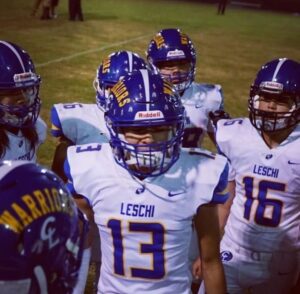 Chief Leschi Schools is a K-12 institution consisting of elementary, middle, and high school levels. It is an all-Native American school that strongly embodies its culture and athletics. I played football, basketball, and ran track. As athletes of this school, we carry much more with us than just our gear or game faces; we carry years of tradition and the pride of our ancestors. As students and athletes, we are consistently reminded of this through a practice we call “circle.” At circle, we engage in our culture by singing songs and dancing. Many of our athletes participate, while some choose to drum, and others opt to sing. In our school’s logo, you may notice feathers. A feather in Native American culture symbolizes many things, such as pride, protection, understanding, and faith, all of which are very important to our school and community. We display these symbols on our jerseys and uniforms, showcasing our culture. There are many times I recall being proud to showcase my school pride and culture. When I was sent off from school to the WIAA Track and Field state championships in Yakima, I felt immense support and pride walking those halls, accompanied by the songs I grew up with. These are the same songs I remember from childhood. We drum out all of our athletes for state to show respect and honor for demonstrating what it means to be a Chief Leschi Warrior.
Chief Leschi Schools is a K-12 institution consisting of elementary, middle, and high school levels. It is an all-Native American school that strongly embodies its culture and athletics. I played football, basketball, and ran track. As athletes of this school, we carry much more with us than just our gear or game faces; we carry years of tradition and the pride of our ancestors. As students and athletes, we are consistently reminded of this through a practice we call “circle.” At circle, we engage in our culture by singing songs and dancing. Many of our athletes participate, while some choose to drum, and others opt to sing. In our school’s logo, you may notice feathers. A feather in Native American culture symbolizes many things, such as pride, protection, understanding, and faith, all of which are very important to our school and community. We display these symbols on our jerseys and uniforms, showcasing our culture. There are many times I recall being proud to showcase my school pride and culture. When I was sent off from school to the WIAA Track and Field state championships in Yakima, I felt immense support and pride walking those halls, accompanied by the songs I grew up with. These are the same songs I remember from childhood. We drum out all of our athletes for state to show respect and honor for demonstrating what it means to be a Chief Leschi Warrior.
As a basketball player, our culture was often reflected at games. One memorable occasion was during the District 4 championships. As a smaller school with diverse students, we don’t have a band like other schools. Instead, our parents and fans brought our traditional drums. This unique sound distinguished us from the bands, allowing the drums to stand out. Although we lacked a conventional band, this made us feel confident and allowed us to embrace our culture, which makes us unique as a school and community. Chief Leschi Schools are full of talented athletes in every sport and activity. Sports show our unique culture and traditions in many ways, such as the last names of some of our students. As Native American students, we have last names that date back to our ancestors. When opposing teams announce our names, this demonstrates our culture. Spectators may have never heard of these names. We will always be proud of our last names, as in Native American culture, we carry our names with tremendous pride.
There are many things about Chief Leschi Schools that I would want people to know. One of those things is that talent is all around. Not just athletically, but academically. We have some of the most intelligent individuals. You can shine and excel no matter your race, gender, or age. I believe this is something that reflects Chief Leschi. We will always do our absolute best in everything we do.
Bus Chants: Ellensburg Softball – By Cheyenne Shewell, Ellensburg (’25)
BUS CHANTS: ELLENSBURG SOFTBALL – BY CHEYENNE SHEWELL, ELLENSBURG (’25)
Unified Basketball at Hermiston High – By Cate Doherty, Hermiston HS (’26)
UNIFIED BASKETBALL AT HERMINSTON HIGH – BY CATE DOHERTY, HERMINSTON HS (’26)
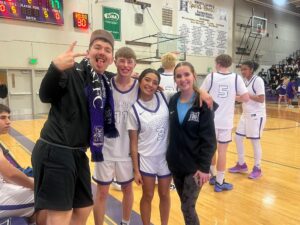 When was the last time you went to a sporting event where over 200 students came out to cheer on both teams? When was the last time you saw athletes who didn’t care about the score but were just grateful for the opportunity to play? When was the last time you saw an educator with 30 years of experience say that it was the best event they had ever witnessed? At Hermiston High School, we all saw this come to life this winter when we started our Unified Basketball team.
When was the last time you went to a sporting event where over 200 students came out to cheer on both teams? When was the last time you saw athletes who didn’t care about the score but were just grateful for the opportunity to play? When was the last time you saw an educator with 30 years of experience say that it was the best event they had ever witnessed? At Hermiston High School, we all saw this come to life this winter when we started our Unified Basketball team.
Unified Basketball is part of Special Olympics and works to create an inclusive opportunity for students with intellectual and physical disabilities. The focus of Unified Basketball is to have a fun and rewarding experience, while providing students an opportunity to participate in a high school sport. The teams are formed of three differently-abled student athletes with two player helpers, which are subbed on and off the court at five minute intervals. There is a running clock, which provides non-stop action on the court.
After being inspired at our October LEAP meeting, I spoke with our school’s Athletic Director, Larry Usher, to see what opportunities there were to connect with others through sports. He knew I volunteered with our special needs students and told me that our school was beginning a Unified Basketball team and asked if I would like to help coach. I eagerly accepted. I immediately started recruiting athletes, both with and without disabilities. I encouraged our special needs students too, I also recruited our varsity athletes to volunteer as player helpers. After a month of practice, it was time for our first game. Emotions were running high, and we had no idea how our athletes would respond to hundreds of people yelling and cheering them on. Our ASB and school administration had been actively encouraging students to pack the student section, and teachers to pack the stands, even petitioning coaches to start practices after the game so that athletes could support our Unified team.
Fitted out with brand-new Nike uniforms, our Unified athletes lined up for introductions. With a roaring crowd, they ran through a tunnel of cheerleaders to the adoring students. The best part? Our crowd cheered just as hard for the other team, with athletes from each team beaming from ear to ear. The game was action-packed, with both teams feeding off the energy of the cheering crowd full of families, students, teachers, and community members. After a very close game, our Hermiston team lost by two points, but it didn’t seem to matter to anyone. Even though we had lost, every person in the audience walked out with a smile on their face and a full, happy heart. Our athletes were ecstatic and just wanted to have another game.
Unified Basketball season was one of the high points of my high school career. On game days, when our athletes walked through the halls wearing their brand-new Nike sweatsuits, every student sincerely wished them good luck. For away games, our team was able to ride on the decked-out Hermiston “Rooter Bus.” For our final game, our main gym was packed full of community members who had heard about the amazing experience of attending a Unified Basketball game. Before the game, each player was given fresh flowers courtesy of the Hermiston FFA. While holding the flowers, both teams went in front of the student section to take a picture, which is now displayed on the windows of the main office.
Everyone who was able to attend one of our games can tell you how incredible the experience was. Our 14 athletes can tell you how impactful it was in their lives. The best part? They all made new friends and got to experience the rush of taking the court like our other varsity teams experience. Our special education teachers can tell you about the positive impact this program had on performance in class. The entire coaching staff and I can tell you how rewarding it is to coach athletes who are so excited for the opportunity to play basketball. The only downside to having a Unified Basketball team is that no sporting experience will probably ever top it.
I implore each of you to develop a Unified Basketball team in your school or community and give these differently-abled athletes the opportunity to have a quintessential high school experience. You just might find that this life-changing experience affects school spirit, the community, and you every bit as much as it does the Unified athletes.
Balancing Life, Sports, and School: A Key to Success – By Abel Garcia, Royal HS (’26)
BALANCING LIFE, SPORTS, AND SCHOOL: A KEY TO SUCCESS – BY ABEL GARCIA, ROYAL HS (’26)
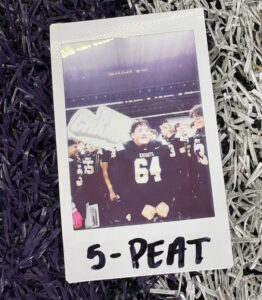 High school is an exciting time filled with new challenges, opportunities, and growth. For student-athletes, finding the right balance between sports, academics, and personal life can feel overwhelming at times, but it’s also essential for success. Getting that balance right not only helps students excel academically and athletically but also supports mental well-being and personal growth.
High school is an exciting time filled with new challenges, opportunities, and growth. For student-athletes, finding the right balance between sports, academics, and personal life can feel overwhelming at times, but it’s also essential for success. Getting that balance right not only helps students excel academically and athletically but also supports mental well-being and personal growth.
Student-athletes often have jam-packed days with early morning practices, after-school games, late-night homework, and constant juggling of commitments. While succeeding in both sports and school can feel rewarding, it can also lead to stress and burnout if balance isn’t maintained. This is where time management becomes key. Knowing how to manage your schedule effectively can help ensure schoolwork gets done on time, while still leaving room for rest, social time, and family moments.
The Power of Mental Breaks
In all the hustle, it’s easy to forget how important it is to take mental breaks. Just like your body needs rest after a tough workout, your mind needs time to relax too. Taking regular breaks throughout the day is essential for staying sharp, reducing stress, and keeping a healthy perspective. Whether it’s stepping outside for a few minutes, listening to your favorite music, or hanging out with friends, these breaks help you recharge, refresh, and come back ready to tackle your next task.
In addition to academics and sports, looking after your personal well-being is super important. Making time for self-care—like getting enough sleep, eating well, or simply relaxing—helps lower stress and prevents burnout. Plus, stepping away from sports and school once in a while can give you the mental reset you need to perform your best both in the classroom and on the field.
Being involved in sports teaches valuable lessons, such as discipline, teamwork, and resilience. But these lessons only work if they’re balanced with schoolwork and life outside of sports. Setting realistic goals, staying positive, and staying organized are all ways to manage both school and sports successfully. Plus, having support from teachers, coaches, and teammates is crucial. When athletes are encouraged to focus on their mental and emotional health, they’re more likely to succeed across the board.
At the end of the day, learning to balance life, sports, and school gives students an important life lesson: it’s not about being perfect in just one area, but about thriving in
multiple parts of life while still maintaining happiness and well-being. By finding that balance, student-athletes can reach their potential in both sports and academics—and set themselves up for success in the future, equipped with the skills they’ll need to handle the demands of adulthood.
Don’t Forget the Hype – By Bryn Beckman, Rainier (’25)
DON’T FORGET THE HYPE – BY BRYN BECKMAN, RAINIER (’25)
Stanwood Spartans Girls Swim Team’s Journey to Excellence – By Taylor Almanza, Stanwood (’26)
STANWOOD SPARTANS GIRLS SWIM TEAM’S JOURNEY TO EXCELLENCE – BY TAYLOR ALMANZA, STANWOOD HS (’26)
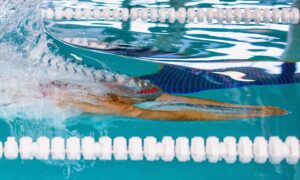 The Stanwood Spartan girl’s swim team can be defined as excellent. They have created a family and culture, they have the perseverance and determination to make it far, and they are passionate about what they do.
The Stanwood Spartan girl’s swim team can be defined as excellent. They have created a family and culture, they have the perseverance and determination to make it far, and they are passionate about what they do.
Overcoming Challenges
From the outside, it looks like the Stanwood girl’s swim team is super successful. They are undefeated this year for the first time in Stanwood swim history. One thing people don’t look at is how much success they have, not just statistically. The Stanwood girl’s swim team is constantly making goals everyday and they are reaching them, they are pushing themselves and their teammates to be better, making more goals to work towards. Senior Sarah Zastoupil explains that, “over the summer, [she] had a goal of reaching a time of 500 and leading lane six during the high school season”. She put in the work all summer and achieved that goal. When asking coach Rita Peterson about challenges, she reveals that “the main challenges high school athletes have to face is balancing school, family, and sometimes work”. Balance is a challenge for anyone, and that is one thing the Stanwood girl’s swim team is amazing at overcoming. Senior Faith Dilworth adds that one thing athletes have to face is “time management, as well as mental stress”. She understands the challenges and she, as well as the rest of the team, has overcome time management and handles stress very well.
Memories
The Stanwood girl’s swim team has made some amazing memories over their excellent season. Freshman Anna Paul’s favorite memory is their “team sleepover”. It made them grow closer and it was a really fun night. Faith Dilworth’s favorite memory was their “high stakes meet against Glacier Peak”. Coach Peterson agrees with that as that is also her favorite memory. She said that something special about this was, finding out that they had “beat Glacier Peak, who had won 40 meets in a row, and knowing that [they] had broken that winning streak”. That memory had proven to themselves that they were capable of more than they thought. They realized how good they really were and how far they could really make it. Two years ago they lost to Glacier Peak by 120 points and this year they beat them 88-82. The depth of their team has helped them so much and it is exciting for the Stanwood community to see a growing program.
Family and Culture
The Stanwood girl’s swim team has built an absolutely amazing program. After watching just 10 minutes of a practice or meet, you can see the culture they have created. After talking with their team they also feel the strong culture of their team. In almost every question asked, culture and chemistry is brought up. Senior Faith Dilworth says, “we all support each other really well” and “we have a really good community and the coaches always help you reach your goals”. Senior Sarah Zastoupil says, “my teammates are the ones helping me beat my goals”, adding on that “one time they even helped me swim two more laps after I thought I couldn’t keep going”. Freshman Anna Paul says that her favorite part of practice is just being in a lane with such amazing girls. She says that, “they are a good group of people and they help you to keep going”. Coach Peterson says, “they have many diverse personalities”. They have 40 girls on the team and she says “they work together and support each other”. She comments on how their team is successful because of “how hard they train together” and she sees “swimmers push themselves past where they thought they could go during tough sets”.
The Positive Effect of High School Athletics on Black Athletes – By Bernie Anderson, Holy Names Academy (’26)
THE POSITIVE EFFECT OF HIGH SCHOOL ATHLETICS ON BLACK ATHLETES – BY BERNIE ANDERSON, HOLY NAMES ACADEMY (’26)
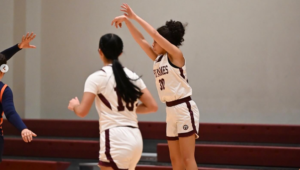 The effect high school sports have on Black athletes is more than one might think. While many students love and enjoy their high school sports team, this connection is more deeply rooted in Black athletes at predominantly white institutions (PWI). Many Black students come to school every day and do not see representation in themselves as they walk the halls. For the schools that do not have a strong Black community, sports can be a grounding point for many athletes searching for a cultural connection.
The effect high school sports have on Black athletes is more than one might think. While many students love and enjoy their high school sports team, this connection is more deeply rooted in Black athletes at predominantly white institutions (PWI). Many Black students come to school every day and do not see representation in themselves as they walk the halls. For the schools that do not have a strong Black community, sports can be a grounding point for many athletes searching for a cultural connection. 

